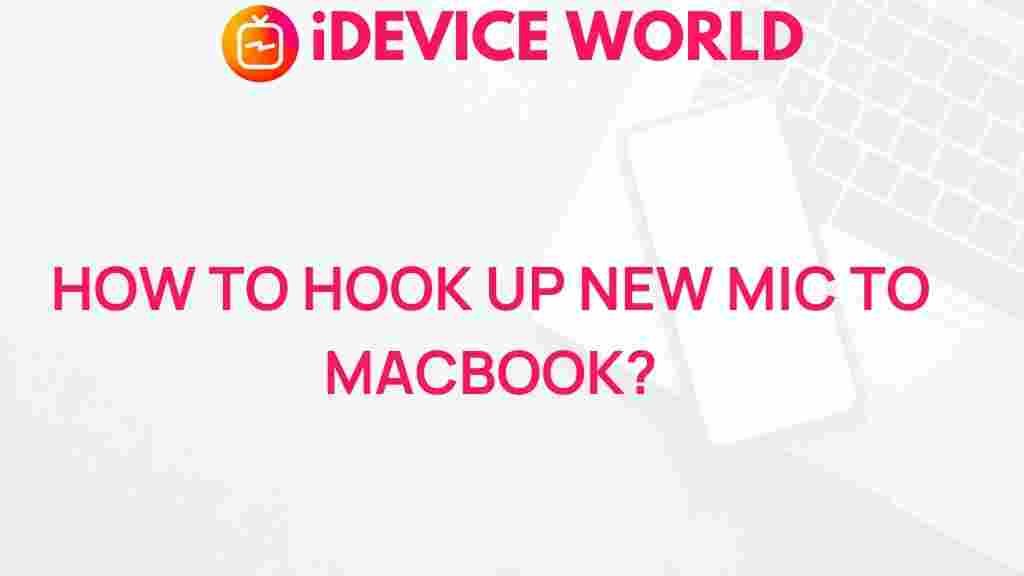Microphone: Unleash Your Creative Side
In today’s digital age, a good microphone can transform your recording experience. Whether you’re a podcaster, musician, or content creator, understanding how to connect a new microphone to your MacBook is essential for high-quality sound. This guide will walk you through the process of setting up your microphone, ensuring that you can capture your creativity with clarity and precision.
Understanding Microphones
Before diving into the setup process, it’s important to understand the types of microphones available and their features:
- Dynamic Microphones: Ideal for live performances, they are durable and can handle high sound pressure levels.
- Condenser Microphones: Great for studio recordings, they are sensitive and capture a wide range of frequencies.
- Lavalier Microphones: Small and discreet, perfect for interviews or presentations.
- USB Microphones: Easy to use and connect directly to your computer without additional equipment.
Choosing the right microphone for your needs will enhance your recording quality. Now, let’s explore how to connect a microphone to your MacBook.
Step-by-Step Process to Connect a Microphone to Your MacBook
Connecting a microphone to your MacBook is a straightforward process. Follow these steps to get started:
Step 1: Gather Your Equipment
Make sure you have the following:
- Your chosen microphone
- A compatible audio interface (if using an XLR microphone)
- USB cable (for USB microphones)
- Headphones for monitoring audio
Step 2: Connect Your Microphone
Depending on the type of microphone, the connection method will differ:
- USB Microphone: Simply plug the USB cable into an available USB port on your MacBook.
- XLR Microphone: Connect the microphone to an audio interface using an XLR cable. Then, connect the audio interface to your MacBook via USB.
Step 3: Configure Your MacBook Settings
Once your microphone is connected, you need to configure your MacBook’s audio settings:
- Click on the Apple Menu in the top-left corner.
- Select System Preferences.
- Click on Sound.
- Navigate to the Input tab.
- Select your microphone from the list of available devices.
- Adjust the input volume to your preference.
Step 4: Test Your Microphone
Testing your microphone ensures it’s working properly:
- Open a recording application like GarageBand or QuickTime Player.
- Start a new audio recording and speak into the microphone.
- Playback the recording to check the audio quality.
Troubleshooting Common Microphone Issues
If you encounter issues while connecting your microphone, try these troubleshooting tips:
No Sound from Microphone
- Ensure the microphone is properly connected.
- Check if the microphone is selected as the input device in the sound settings.
- Adjust the input volume slider in the sound preferences.
Poor Audio Quality
- Check the microphone placement; ensure it’s close to the sound source.
- Eliminate background noise as much as possible.
- Use headphones to monitor audio and adjust settings accordingly.
Microphone Not Recognized
- Disconnect and reconnect the microphone.
- Restart your MacBook to refresh the system.
- Try using a different USB port or cable.
Additional Resources
For further reading on optimizing your audio recordings, check out this helpful guide on audio engineering techniques.
Also, for tips on selecting the right microphone for your needs, you can visit our microphone selection guide.
Conclusion
Connecting a microphone to your MacBook is a simple yet crucial step in unleashing your creative side. By following the steps outlined above, you can easily set up your microphone and start recording high-quality audio. Whether you’re recording music, podcasts, or videos, a well-configured microphone can significantly enhance your sound quality. Don’t forget to troubleshoot any issues and make the most of your equipment. Now, get out there and let your creativity shine!
This article is in the category Guides & Tutorials and created by iDeciveWorld Team
